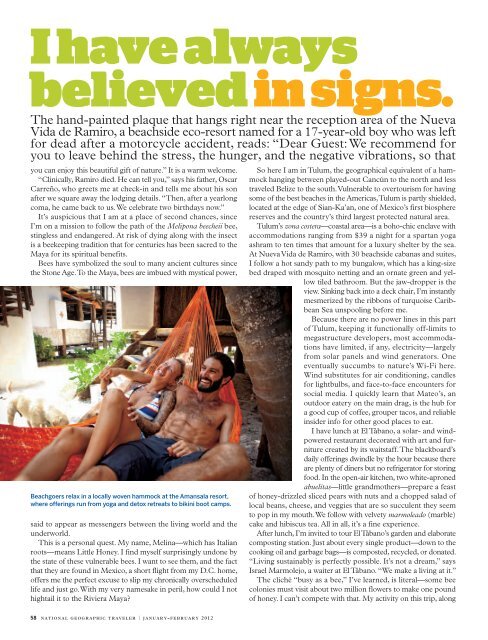At Amansala, an eco- resort in Tulum, clay body ... - Bikini Bootcamp
At Amansala, an eco- resort in Tulum, clay body ... - Bikini Bootcamp
At Amansala, an eco- resort in Tulum, clay body ... - Bikini Bootcamp
Create successful ePaper yourself
Turn your PDF publications into a flip-book with our unique Google optimized e-Paper software.
I have always<br />
believed <strong>in</strong> signs.<br />
The h<strong>an</strong>d-pa<strong>in</strong>ted plaque that h<strong>an</strong>gs right near the reception area of the Nueva<br />
Vida de Ramiro, a beachside <strong>eco</strong>-<strong>resort</strong> named for a 17-year-old boy who was left<br />
for dead after a motorcycle accident, reads: “Dear Guest: We r<strong>eco</strong>mmend for<br />
you to leave beh<strong>in</strong>d the stress, the hunger, <strong>an</strong>d the negative vibrations, so that<br />
you c<strong>an</strong> enjoy this beautiful gift of nature.” It is a warm welcome.<br />
“Cl<strong>in</strong>ically, Ramiro died. He c<strong>an</strong> tell you,” says his father, Oscar<br />
Carreño, who greets me at check-<strong>in</strong> <strong>an</strong>d tells me about his son<br />
after we square away the lodg<strong>in</strong>g details. “Then, after a yearlong<br />
coma, he came back to us. We celebrate two birthdays now.”<br />
It’s auspicious that I am at a place of s<strong>eco</strong>nd ch<strong>an</strong>ces, s<strong>in</strong>ce<br />
I’m on a mission to follow the path of the Melipona beecheii bee,<br />
st<strong>in</strong>gless <strong>an</strong>d end<strong>an</strong>gered. <strong>At</strong> risk of dy<strong>in</strong>g along with the <strong>in</strong>sect<br />
is a beekeep<strong>in</strong>g tradition that for centuries has been sacred to the<br />
Maya for its spiritual benefits.<br />
Bees have symbolized the soul to m<strong>an</strong>y <strong>an</strong>cient cultures s<strong>in</strong>ce<br />
the Stone Age. To the Maya, bees are imbued with mystical power,<br />
Beachgoers relax <strong>in</strong> a locally woven hammock at the <strong>Am<strong>an</strong>sala</strong> <strong>resort</strong>,<br />
where offer<strong>in</strong>gs run from yoga <strong>an</strong>d detox retreats to bik<strong>in</strong>i boot camps.<br />
said to appear as messengers between the liv<strong>in</strong>g world <strong>an</strong>d the<br />
underworld.<br />
This is a personal quest. My name, Mel<strong>in</strong>a—which has Itali<strong>an</strong><br />
roots—me<strong>an</strong>s Little Honey. I f<strong>in</strong>d myself surpris<strong>in</strong>gly undone by<br />
the state of these vulnerable bees. I w<strong>an</strong>t to see them, <strong>an</strong>d the fact<br />
that they are found <strong>in</strong> Mexico, a short flight from my D.C. home,<br />
offers me the perfect excuse to slip my chronically overscheduled<br />
life <strong>an</strong>d just go. With my very namesake <strong>in</strong> peril, how could I not<br />
hightail it to the Riviera Maya?<br />
58 NATIONAL GEOGRAPHIC TRAVELER | JANUARY- FEBRUARY 2012<br />
So here I am <strong>in</strong> <strong>Tulum</strong>, the geographical equivalent of a hammock<br />
h<strong>an</strong>g<strong>in</strong>g between played-out C<strong>an</strong>cún to the north <strong>an</strong>d less<br />
traveled Belize to the south. Vulnerable to overtourism for hav<strong>in</strong>g<br />
some of the best beaches <strong>in</strong> the Americas, <strong>Tulum</strong> is partly shielded,<br />
located at the edge of Si<strong>an</strong>-Ka’<strong>an</strong>, one of Mexico’s first biosphere<br />
reserves <strong>an</strong>d the country’s third largest protected natural area.<br />
<strong>Tulum</strong>’s zona costera—coastal area—is a boho-chic enclave with<br />
accommodations r<strong>an</strong>g<strong>in</strong>g from $39 a night for a spart<strong>an</strong> yoga<br />
ashram to ten times that amount for a luxury shelter by the sea.<br />
<strong>At</strong> Nueva Vida de Ramiro, with 30 beachside cab<strong>an</strong>as <strong>an</strong>d suites,<br />
I follow a hot s<strong>an</strong>dy path to my bungalow, which has a k<strong>in</strong>g-size<br />
bed draped with mosquito nett<strong>in</strong>g <strong>an</strong>d <strong>an</strong> ornate green <strong>an</strong>d yellow<br />
tiled bathroom. But the jaw-dropper is the<br />
view. S<strong>in</strong>k<strong>in</strong>g back <strong>in</strong>to a deck chair, I’m <strong>in</strong>st<strong>an</strong>tly<br />
mesmerized by the ribbons of turquoise Caribbe<strong>an</strong><br />
Sea unspool<strong>in</strong>g before me.<br />
Because there are no power l<strong>in</strong>es <strong>in</strong> this part<br />
of <strong>Tulum</strong>, keep<strong>in</strong>g it functionally off-limits to<br />
megastructure developers, most accommodations<br />
have limited, if <strong>an</strong>y, electricity—largely<br />
from solar p<strong>an</strong>els <strong>an</strong>d w<strong>in</strong>d generators. One<br />
eventually succumbs to nature’s Wi-Fi here.<br />
W<strong>in</strong>d substitutes for air condition<strong>in</strong>g, c<strong>an</strong>dles<br />
for lightbulbs, <strong>an</strong>d face-to-face encounters for<br />
social media. I quickly learn that Mateo’s, <strong>an</strong><br />
outdoor eatery on the ma<strong>in</strong> drag, is the hub for<br />
a good cup of coffee, grouper tacos, <strong>an</strong>d reliable<br />
<strong>in</strong>sider <strong>in</strong>fo for other good places to eat.<br />
I have lunch at El Táb<strong>an</strong>o, a solar- <strong>an</strong>d w<strong>in</strong>dpowered<br />
restaur<strong>an</strong>t d<strong>eco</strong>rated with art <strong>an</strong>d furniture<br />
created by its waitstaff. The blackboard’s<br />
daily offer<strong>in</strong>gs dw<strong>in</strong>dle by the hour because there<br />
are plenty of d<strong>in</strong>ers but no refrigerator for stor<strong>in</strong>g<br />
food. In the open-air kitchen, two white-aproned<br />
abuelitas—little gr<strong>an</strong>dmothers—prepare a feast<br />
of honey-drizzled sliced pears with nuts <strong>an</strong>d a chopped salad of<br />
local be<strong>an</strong>s, cheese, <strong>an</strong>d veggies that are so succulent they seem<br />
to pop <strong>in</strong> my mouth. We follow with velvety marmoleado (marble)<br />
cake <strong>an</strong>d hibiscus tea. All <strong>in</strong> all, it’s a f<strong>in</strong>e experience.<br />
After lunch, I’m <strong>in</strong>vited to tour El Táb<strong>an</strong>o’s garden <strong>an</strong>d elaborate<br />
compost<strong>in</strong>g station. Just about every s<strong>in</strong>gle product—down to the<br />
cook<strong>in</strong>g oil <strong>an</strong>d garbage bags—is composted, recycled, or donated.<br />
“Liv<strong>in</strong>g susta<strong>in</strong>ably is perfectly possible. It’s not a dream,” says<br />
Israel Marmolejo, a waiter at El Táb<strong>an</strong>o. “We make a liv<strong>in</strong>g at it.”<br />
The cliché “busy as a bee,” I’ve learned, is literal—some bee<br />
colonies must visit about two million flowers to make one pound<br />
of honey. I c<strong>an</strong>’t compete with that. My activity on this trip, along


